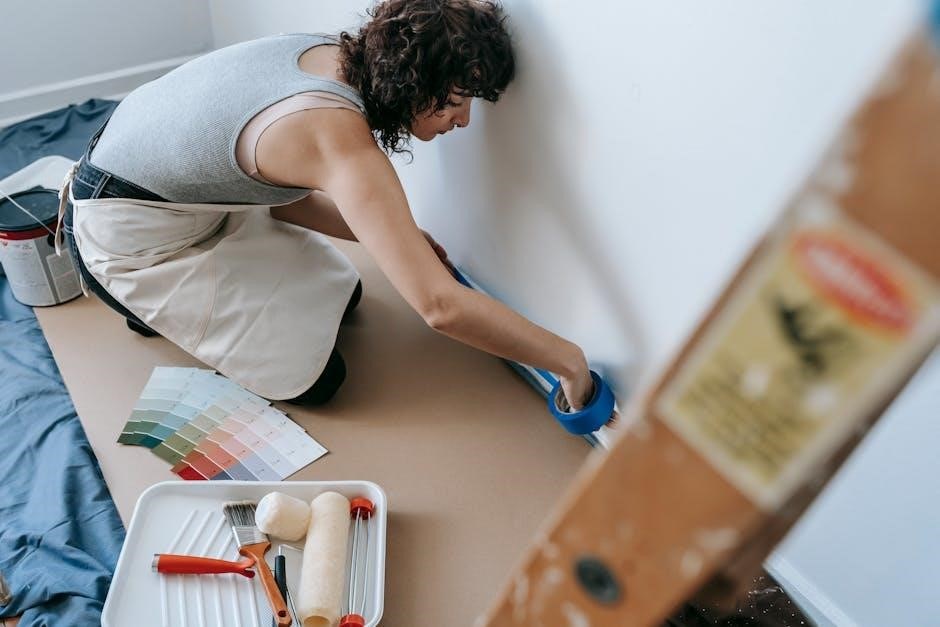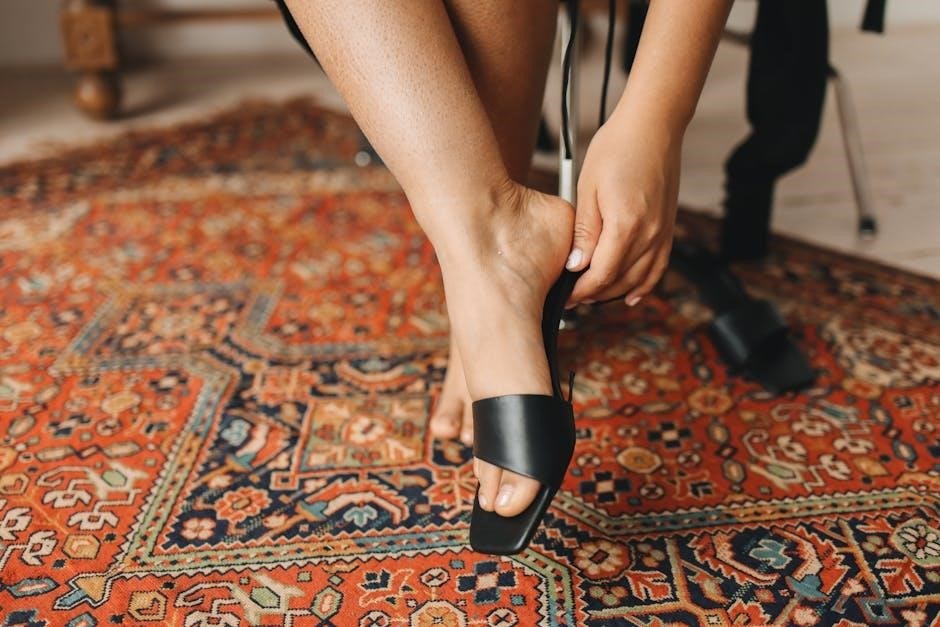Understanding adult shoe sizes is crucial for comfort and proper foot health․ This guide helps navigate the complexities of sizing, ensuring a perfect fit for every foot shape and type․
With varying measurements across brands, finding the right size can be challenging․ This section introduces key factors like length, width, and measurement techniques to simplify your shoe selection process․
Whether you’re shopping for casual wear or athletic footwear, this guide provides essential insights to help you make informed decisions and avoid common sizing mistakes․
Understanding Shoe Sizes
Shoe sizes represent foot length and width measurements, varying across brands and regions․ The Mondopoint system offers precise sizing, while US, UK, and EU systems differ slightly․
2․1․ What Shoe Size Represents
A shoe size represents a combination of foot length and width, typically expressed as a numbered value․ The Mondopoint system measures foot length in centimeters and includes width, while US, UK, and EU sizes focus primarily on length․ Shoe sizes vary slightly between brands due to differences in lasts and fit models․ Understanding your precise measurements ensures proper fit and comfort․ Always refer to size charts or try shoes on to confirm the best fit for your foot shape and type․
2․2․ Standard vs․ Narrow vs․ Wide Widths
Shoe widths cater to different foot shapes, ensuring optimal comfort․ Standard width fits most people, offering a balanced fit․ Narrow widths are designed for slimmer feet, while wide widths accommodate broader feet or conditions like bunions․ Proper width is crucial for comfort and foot health․ Ill-fitting widths can cause discomfort or even lead to foot issues․ Always check size charts, as definitions vary slightly between brands․ Selecting the right width ensures your shoes feel comfortable and supportive, whether for daily wear or specific activities․
2․3․ Why Different Brands Have Different Sizing
Different brands often have varying sizing due to unique design approaches and measurement standards․ While some brands prioritize comfort, others focus on fashion, leading to discrepancies in fit․ Materials and construction methods also play a role, as stiffer or softer materials can affect how a shoe molds to the foot․ Additionally, shoe styles like sneakers, boots, or sandals have distinct fits, contributing to size variations․ Brands may use different measurement systems, such as Brannock vs․ Mondopoint, or cater to specific foot shapes, further complicating sizing consistency․ This variability highlights the importance of trying shoes on or relying on brand-specific size charts for accuracy․

Factors Affecting Shoe Fit
Foot length, arch type, and heel fit are key factors influencing shoe comfort․ Proper fit ensures optimal support and prevents discomfort or injury․
Understanding these elements helps in selecting shoes that align with your foot shape and personal comfort needs․
3․1․ Foot Length and Toe Box
Foot length is the primary factor in determining shoe size, as it directly impacts comfort and fit․ The toe box, which houses the toes, should provide adequate space to prevent compression and allow natural movement․
A proper fit ensures the toes have about half an inch of room to move freely․ Measuring foot length accurately at home is essential to avoid sizing errors․ Incorrect sizing can lead to discomfort, blisters, or even long-term foot issues․
When trying shoes, ensure the toe box aligns with your foot’s natural shape and doesn’t feel restrictive․ This balance is key to optimal comfort and support during daily activities or athletic pursuits․
3․2․ Arch and Instep Measurements
The arch and instep measurements are crucial for ensuring proper shoe fit․ The instep, the top of the foot, varies in width and shape, influencing how securely the shoe holds the foot․
A well-fitting shoe supports the arch without causing pressure points․ Those with high arches may need additional cushioning, while flat feet might require more structured support to maintain stability․
Measuring the instep ensures the shoe isn’t too tight or loose, promoting even distribution of pressure․ This balance is essential for comfort and to prevent issues like bunions or plantar fasciitis․
3․3․ Heel Fit and Comfort
A proper heel fit is essential for comfort and stability․ A snug yet comfortable heel prevents excessive movement, reducing the risk of blisters and discomfort during walking or running․
The heel should not slip excessively but also shouldn’t feel overly tight․ Proper cushioning and padding in the heel area enhance comfort, especially for those with sensitive feet․
Shoes with adjustable features, like lacing systems or heel counters, can provide a customized fit․ Ensuring the heel fits well is vital for overall shoe comfort and performance․

How to Measure Your Feet at Home
To measure your feet at home, start by gathering a ruler, pen, and paper․ Stand on the paper, tracing the outline of both feet with a straight pen․ Measure the longest foot’s length and width, ensuring accuracy․ Use a shoe size chart to determine your size, considering brand-specific variations for the best fit․
4․1․ Tools Needed for Measurement
To accurately measure your feet at home, you’ll need a few simple tools․ Start with a flat ruler or a tape measure for precise length and width measurements․ Place a sheet of paper on the floor and trace the outline of your foot using a pen or pencil․ A wall can help stabilize your foot during tracing․ Additionally, a shoe size chart or a printable foot measurement guide can provide a reference point․ For optimal accuracy, measure both feet, as they may differ slightly․ Ensure the ruler is aligned straight to avoid distortions․ These tools will help you determine your exact shoe size effortlessly at home․
4․2․ Step-by-Step Measurement Process
Begin by placing a sheet of paper on a flat surface and standing barefoot․ Position your foot on the paper, ensuring your weight is evenly distributed․ Hold a pencil or pen vertically at a 90-degree angle to the paper and trace the outline of your foot․ Repeat for both feet․ Next, use a ruler to measure the longest part of your foot and the widest part across the ball․ Record these measurements․ Compare them to a shoe size chart to determine your size․ Ensure the ruler is straight and the foot is not angled for accurate results․ This method provides reliable data for selecting the right shoe fit․
4․3․ Interpreting Your Measurements
Once you’ve measured your foot length and width, compare these values to a standard shoe size chart․ Most charts provide corresponding sizes based on inches or centimeters․ Ensure to use the larger foot’s measurements, as feet often differ slightly․ If your measurement falls between sizes, consider rounding up for comfort․ Width measurements will help determine if you need a narrow, standard, or wide fit․ Keep in mind that sizing can vary between brands, so refer to the specific brand’s chart for accuracy․ Accurate interpretation ensures a proper fit, preventing discomfort or premature wear․ Always double-check your measurements for reliability before selecting a size․

Shoe Size Conversion Guide
This section provides a comprehensive comparison of US, UK, EU, and Mondopoint sizing systems, offering tools to convert measurements accurately for the perfect fit across different regions and brands․
5․1․ US to UK Shoe Size Conversion
Converting US to UK shoe sizes involves understanding the numerical differences and foot length measurements․ For example, a US size 7 corresponds to a UK size 6, with both fitting a 9․7-inch foot․ This conversion applies to men’s and women’s sizes, ensuring consistency across regions․ To accurately convert, refer to a size chart that aligns US and UK sizes with precise foot lengths․ This helps avoid mismatches and guarantees a comfortable fit․ Always measure both feet and use the longer foot’s length for the most accurate conversion․ This guide simplifies the process, making it easier to shop internationally with confidence․
5․2․ EU to US Shoe Size Conversion
Converting EU to US shoe sizes involves understanding the numerical differences based on foot length․ EU sizes are calculated using the Paris Point system, where each size represents 2/3 of a centimeter in foot length․ For example, an EU size 40 corresponds to a US size 7 for men and a US size 8 for women․ This conversion ensures consistency across regions, though slight variations may exist between brands․ To ensure accuracy, measure your foot length and compare it to the size chart․ Always consider both feet, as they may differ slightly․ This guide helps you navigate international sizing seamlessly for the perfect fit․
5․3․ Mondopoint System Explained
The Mondopoint system measures shoe sizes using centimeters, focusing on foot length and width for accuracy․ It records foot length in 1cm increments, providing a precise fit․ Unlike traditional systems, Mondopoint also considers foot width, offering better comfort․ This method is popular in athletic footwear and specialty shoes, ensuring reduced sizing errors․ While not universally adopted, it’s widely used in Europe and Asia․ Mondopoint’s dual measurement approach helps avoid common fit issues, making it a preferred choice for those seeking optimal comfort and performance in their footwear․

Selecting the Right Shoe Fit
Proper shoe fit is essential for comfort and performance․ Ensure toes have room to move, and the heel fits snugly without slipping․ Try shoes on in the afternoon, as feet swell during the day․
Consider foot shape, arch type, and personal comfort preferences․ Avoid tight or overly loose fits, as they can lead to discomfort or injury over time․
6․1․ Importance of Proper Fit for Comfort
A proper fit is essential for comfort, as it prevents blisters, calluses, and foot pain․ Shoes that are too tight can restrict movement, while loose shoes may cause slipping, leading to discomfort during wear․
Properly fitted shoes support the arch and heel, ensuring stability and reducing the risk of injuries․ They also allow for adequate airflow, keeping feet cool and dry, which is crucial for long-term comfort and foot health․
Ill-fitting shoes can lead to chronic issues like bunions or hammertoes, emphasizing the importance of selecting the right size and style․ Always consider foot shape, activity type, and personal comfort preferences when choosing footwear․
Remember, well-fitting shoes not only enhance comfort but also improve overall well-being and confidence․ They are an investment in both short-term ease and long-term foot health․
6․2․ Choosing the Right Width
Selecting the correct shoe width is vital for comfort and proper fit․ Most shoes come in standard, narrow, or wide options, catering to different foot shapes․ Ignoring width can lead to discomfort, blisters, or restricted movement․
To determine your ideal width, measure your foot’s widest part or try shoes in various widths․ Brands often provide size charts, including width options, to help you choose accurately․ Proper width ensures your toes aren’t cramped and your feet stay secure without feeling tight․
A well-fitting width promotes even weight distribution, reducing pressure points and enhancing overall comfort․ Always prioritize width alongside length for the best fit․
6․3․ Considering Foot Shape and Type
Foot shape and type play a significant role in achieving the perfect shoe fit․ Common foot types include flat feet, high arches, and neutral feet, each requiring specific features in a shoe․ For instance, flat feet benefit from sturdy arch support, while high arches need cushioning and flexibility․ Bunions or wide toe boxes may be necessary for those with toe deformities․ Understanding your foot shape helps in selecting styles that accommodate your needs, ensuring comfort and preventing discomfort or injury․ Always consider your foot type when trying shoes, and opt for brands that cater to your specific requirements․ Proper alignment and support are key to long-term foot health․

Common Mistakes to Avoid
One of the most common mistakes is assuming shoe sizes are consistent across brands, which can lead to poor fit․ Another error is not measuring both feet, as they may differ in size․ Additionally, ignoring shoe width can result in discomfort․ These oversights can cause blisters, poor posture, and long-term foot issues․ Always measure both feet, check width options, and try shoes on if possible․ Proper fit is essential for comfort and foot health․ Avoiding these mistakes ensures a better shopping experience and prevents discomfort․ Proper sizing is key to enjoying your footwear․ Don’t overlook these critical factors when selecting shoes․
7․1․ Assuming Size Consistency Across Brands
One common mistake is assuming shoe sizes are consistent across brands․ However, different brands often have varying sizing standards, leading to inconsistent fits․ For example, a size 9 in one brand may fit like a size 8;5 in another․ This discrepancy arises because brands use different lasts (shoe molds) and materials, affecting the overall fit․ Additionally, some brands cater to specific foot shapes, such as narrow or wide widths, which can further complicate sizing․ To avoid this, it’s essential to refer to each brand’s size chart and consider trying shoes on before purchasing․ Ignoring this can result in discomfort and poor fit․
7․2․ Not Measuring Both Feet
Many people overlook the importance of measuring both feet, assuming they are identical in size․ However, it’s common for one foot to be slightly larger than the other․ Failing to measure both feet can lead to ill-fitting shoes, as using only one foot’s measurement may result in a shoe that is too tight or too loose․ To ensure accuracy, always measure both feet and use the larger foot’s dimensions to determine your shoe size․ This simple step helps avoid discomfort and ensures a proper fit, making it a crucial part of the shoe-buying process․
7․3․ Ignoring Width When Selecting Shoes
Ignoring width when selecting shoes is a common mistake that can lead to discomfort and poor fit․ While shoe size primarily refers to length, width plays a critical role in ensuring proper comfort․ Many people have feet that are narrower or wider than the standard size, and failing to account for this can result in shoes that are too tight or too loose․ This can cause discomfort, blisters, or even long-term foot health issues․ Always consider both length and width when choosing shoes, as this ensures a more accurate and comfortable fit․ Refer to size charts or guides to avoid this oversight․

Special Considerations
Special considerations ensure optimal comfort and support for unique foot needs, addressing various shapes, orthotic requirements, and medical conditions, ensuring the best fit and functionality for every individual․
8․1․ Accommodating Different Foot Shapes
Different foot shapes, such as flat feet, high arches, or bunions, require specialized shoe features for optimal comfort․ Flat feet benefit from sturdy arch support and motion control, while high arches need cushioning and flexibility․ Bunions demand wider toe boxes to alleviate pressure․ Understanding your foot shape helps in selecting shoes with appropriate structural features, ensuring a comfortable fit and preventing discomfort or injuries․ This section explores how various foot shapes can be accommodated with the right shoe design and sizing, promoting long-term foot health and satisfaction․
8․2․ Orthotics and Insoles
Orthotics and insoles play a crucial role in enhancing shoe fit for individuals with specific foot needs․ Custom orthotics are tailored to address issues like flat feet, high arches, or plantar fasciitis, providing targeted support and alignment․ Over-the-counter insoles offer additional cushioning, arch support, or moisture-wicking properties, catering to various comfort preferences․ When combined with properly fitted shoes, orthotics and insoles can significantly improve comfort and reduce discomfort․ It’s important to choose insoles that align with your foot shape and activity level․ Always ensure that orthotics or insoles don’t force your foot into an unnatural position, as this can lead to further issues․ Proper fitting and professional advice are key to maximizing their benefits․

Where to Find Reliable Shoe Size Charts
Reliable shoe size charts can be found on official brand websites, shoe retailers, and specialized footwear platforms․ Many brands provide detailed size guides tailored to their specific designs․ Third-party size conversion tools also offer comparisons across different brands and regions․ Additionally, specialty shoe stores often have in-store measuring services or online charts to help determine your size accurately․ When shopping online, look for websites that include size guides or customer reviews discussing fit․ Printing out size charts at home can also help you measure your feet accurately before ordering․ Always consult multiple sources to ensure consistency and accuracy in your sizing․

Brand-Specific Sizing Information
Each shoe brand often has its own unique sizing standards, which can vary significantly․ Brands like Dr․ Martens, Nike, and Adidas provide detailed size charts tailored to their specific designs․ Some brands, such as Russell & Bromley, offer luxury shoe size guides for both men and women, including UK, EU, and US conversions․ It’s important to consult the sizing information directly from the brand’s website or store to ensure accuracy, as even similar styles can differ in fit․ Many brands also include customer reviews or fit tips to help you choose the right size․ Always check brand-specific charts to avoid sizing mismatches and ensure a perfect fit․
Care Tips for Maintaining Shoe Fit
Proper care is essential to maintain the fit and comfort of your shoes over time․ Regular cleaning with a soft cloth and mild detergent can prevent dirt buildup that may alter the shape․ Storing shoes in a cool, dry place, away from direct sunlight, helps preserve their structure․ For leather shoes, conditioning periodically can prevent cracking and maintain flexibility․ Avoid extreme temperatures, as they can cause materials to expand or contract․ Additionally, using shoe trees or stuffing shoes with paper when not in use can help retain their shape․ Proper care ensures your shoes remain comfortable and true to size for a longer period․

Troubleshooting Discomfort Issues
If your shoes cause discomfort, it’s important to identify the root cause․ Common issues include tight toe boxes, improper width, or insufficient arch support․ Check if your shoes are too tight or too loose, as both can lead to pain․ Consider using insoles or orthotics to address specific foot needs․ If discomfort persists, try a different size or brand, as sizing can vary; Pay attention to the material and cushioning, as these can impact comfort․ For persistent issues, consult a podiatrist for professional advice on footwear selection․ Addressing discomfort early can prevent long-term foot problems and ensure a better fit for your shoes․
The Future of Shoe Sizing Technology
The future of shoe sizing is evolving rapidly with advancements in technology․ Innovations like 3D foot scanning and augmented reality are enabling precise measurements and virtual try-ons․ AI-powered sizing tools analyze foot data to recommend the best fit, reducing sizing errors․ Smart insoles now track foot movement, providing insights to improve shoe design․ Additionally, sustainable manufacturing is gaining traction, with made-to-order shoes minimizing waste․ These technologies aim to enhance comfort, personalization, and efficiency in shoe shopping․ As these innovations become mainstream, consumers can expect a seamless and accurate shoe-sizing experience, ensuring the perfect fit every time․